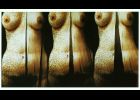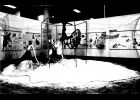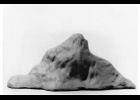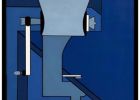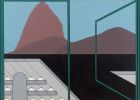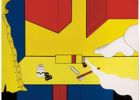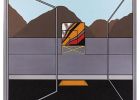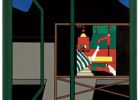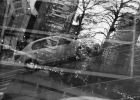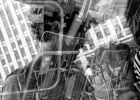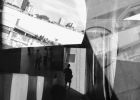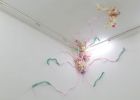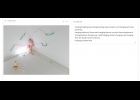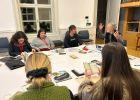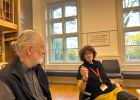Flusser Studies 37 – May 2024 - In Memory of Osmar Gonçalves dos Reis Filho (1980-2024)
Le sandwich postmoderne / On Sandwiches: a Post-Modern Reflection / Vom Sandwich: eine post-moderne Überlegung
Große Zeiten Kleines Glück / Great Times Little Happiness
Not much is known about Vilém Flusser’s childhood years in Prague, where he lived with his family and attended the Deutsches Realgymnasium, a school in Zboroská street. One of his classmates and friends was a girl born in 1919. Eighty years later, she told her extraordinary life to Gerold Tietz who transformed it into the novel Große Zeiten Kleines Glück (Great Times Little Happiness). Flusser who is called Jakob is described as a very smart boy at school – who could even be a little intimidating to his classmates every now and then. He used to sit in the first row – and when Rita, the protagonist of the story, had to do a presentation in front of the class, she always felt particularly observed and critically challenged by his vigilant presence. The different excerpts published here allow a rough insight into the story line and thus also into a part of Vilém Flusser’s childhood.
Flusser était-il féministe? / Was Flusser a Feminist?
One would not spontaneously associate these two words, Flusser and feminism. Many testimonies point to Flusser’s machismo in his personal life: his relationship with Edith was rather traditional, one could even say patriarchal. But, while his personal behavior could not be qualified of feminist, the two texts, presented in this essay, point to a very modern and even somewhat revolutionary view of the relationship between men and women. The first one is his contribution to a book about love, edited by his friend Alexandre Bonnier; the second is his critique in European Photography of the work of the Greek photographer Lizzie Calligas. Flusser acknowledged forcefully that the adoption of a feminist point of view is an intellectual and moral necessity: by subjecting women’s bodies to their own bodies, men have criminally repressed women and prevented a dialogue in favor of a male monologue, thus making men and women strangers to each other, even though they may love each other. Such a point of view would force us to redefine the meaning of the word ‘love’.
Fantasia essata: Behind Flusser’s Theory of Imagination
In several texts Flusser refers to a fantasia essata, an “exact imagination,” attributing this concept to Leonardo da Vinci: a non-arbitrary use of imagination, a dialogue between experience and reason by investigating improbable but possible scenarios. However, Leonardo never used this phrase: it was Goethe who first wrote of an exakte sinnliche Phantasie. This article aims, on the one hand, to reconstruct a genealogy of fantasia essata, and on the other, to investigate the affinity between this exact imagination and Flusser’s notion of Einbildungskraft. Although the expression exakte Phantasie does not date back to the Renaissance, it was used by Cassirer to explain Leonardo’s peculiar imaginative approach to science. The success of this concept is linked to the rediscovery of the dynamic epistemology of Renaissance Humanism (Grassi) before modern exact sciences excluded imagination and locked art in museums. Some mid-20th century thinkers, such as Santillana and Ferreira da Silva, who are likely to be Flusser’s sources, used this concept to think of a productive and operational imagination that could bridge the gap between art and science. This debate could shed new light on Flusser’s theory of second-order imagination, which he also defined as conceptual, reflexive, and philosophical imagination.
“Ein Mensch ist kein Baum.” Vilém Flussers Phänomenologie der Einwanderung
Vilém Flusser was not only a multiple emigrant himself, he also analysed this experience, which he ultimately saw as an integral part of human existence, theoretically, culturally and philosophically. In the reception of this migration theory, little attention has been paid so far to an earlier, programmatic contribution from his Brazilian phase, which is therefore given special attention here: his plea “For a Phenomenology of Immigration” written in 1971 shortly before he remigrated again to Europe. With its counterpart, the “Philosophy of Emigration” written in 1966, it marks the beginning of a series of articles that deal with immigration and emigration as well as general migration, as featured in the philosophical autobiography Bodenlos and the text collection The Freedom of the Migrant.
L’image dilacérée par les calculs et les lettres / A imagem dilacerada por cálculos e letras.
This essay starts out from Flusser’s theory on the contrast between images and writing from the second narrative of creation in the Bible and proceeds in three successive movements: in the first movement of writing science and literature come together, in the second they are separated from each other and in the third a series of equations are constructed which allow researchers to predict the future. The action of the robot, although endowed with a powerful memory, is unable to fit into these movements and thus does not belong to the community of human beings.
Tertium non datur. El tercero excluido
This paper retraces the relationship between Louis Bec’s work for the Bienal de São Paulo Sulfanogrades (1981) and his book with Vilém Flusser, Vampyroteuthis Infernalis (1987). Looking back at the first three exhibitions of the Sulfanogrades in France in 1976, and the subsequent text produced by Flusser for this matter, Orthonature. Paranature, it seems clear that a large part of the vocabulary and many of the ideas contained in Vampyroteuthis Infernalis had already been formulated by 1976, due to the close and regular exchange between Bec and Flusser. In Bec’s and Flusser’s oeuvre the distinction between art and science, nature and culture, animal and human, or truth and fable, is defied and exposed as the wrong way out of the old dilemma of the excluded third, or tertium non datur. Both spheres overlap, rather than being mutually exclusive, and the space of overlapping is no other than that of epistemology. If the Sulfanogrades remove agency from both the human subject and the animal object, ultimately giving all subjective agency to biology, Vampyroteuthis Infernalis exposes a true theory of the human as an inverse vampire, a new model for contemporary artists.
Gesto das Pedras: da fenomenologia flusseriana às coisas de Wanda Pimentel
This essay explores the enigma of gestures through the works of Vilém Flusser and the Brazilian painter Wanda Pimentel by starting from the paradoxical assumption that a rock can perform a gesture. Some paintings from Pimentel’s series Envolvimentos (Entanglements) and Montanhas do Rio (Mountains of Rio) reveal a sort of ambiguous expressiveness of legs, rocks, windows, clothes, and other objects. They seem to be endowed with that which Flusser called the “artificiality” of gestures.
Desaparelho: do protótipo ao conceito / Disapparatus: From Prototype to Concept
This phenomenological essay, based on Flusser’s philosophy, is about a photographic prototype created by the author called Disapparatus which problematizes the very gesture of photography. Technically, the Disapparatus is an optical gadget that, when coupled with a photographic apparatus, produces an overlay of three distinct images. Although initially the interaction with the Disapparatus is similar to that with a normal camera, a more serious engagement reveals a program that does not operate according to traditional photography, such as the hunting for viewpoints. The new game questions the traditional meaning of representation, object, space, and the self. And in this respect, it resembles, to a certain degree, to the classical phenomenological game itself.
“Devir em direção ao perecer”: Flusser, Plásticos, Rodas, e Inteligências Artificiais / "Becoming towards perishing": Flusser, Plastics, Wheels, and Artificial Intelligences
This essay proposes a digression on the permanence and impermanence, the visibility and invisibility of synthetic polymers (also known as plastics) and the role of AI, starting out from an interpretation proposed by Vilém Flusser in his essays “Forma e material” and “Rodas”. It explores the boundaries between form and matter, organic and synthetic, natural and artificial, art and science The text also includes a reflection proposed by Roland Barthes regarding synthetic polymers in his essay “Le plastique”, from the work “Mythologies”. The proteism of plastics could be interpreted as a utopia of total information. The text is accompanied by four images created by a Versatile Diffusion program.
ACTIVE – ARCHIVE – RESEARCH
This essay aims to sum up the preliminary conceptions and the results of an archival research and research lab which was conducted and organized by the author at Artpool Art Research Center, Budapest, in the autumn of 2023, and supported by the Museum of Fine Arts with the participation of seven young researchers. Artpool – this unique artist-archive, presently art research center – also called “active – archive – research”, using Galántai’s term invented in 1979, was founded by him, his wife, and the fellow artist Júlia Klaniczay. Their personal presence in the lab’s research work, “the thought-exchange” – as Galántai understands teaching/learning – provided an opportunity to develop a new research method based on Michael Polanyi’s personal knowledge theory. The essay also highlights the possibilities of exploring parallels between Vilém Flusser’s and György Galántai’s thinking and opens up new perspectives for further research.
The construction of happiness in the world of technical images: from Aristotelian ‘’ευδαιμονία (eudaimonia)’’ to the image-synthesis of Vilém Flusser
This paper explores the concept of happiness in modern times through the lens of Vilém Flusser’s technical image comparing it to the Aristotelian concept of eudaimonia. According to Aristotle, eudaimonia is the supreme good to which human beings should dedicate their life. The process of finding eudaimonia is an extremely difficult journey. Is this concept still valid in the age of technical images that compose the reality around us? What does happiness mean in this situation? How can we give any meaning to it? An answer to these questions can be found in Flusser’s thought.
Flusser e Kafka: diálogos em torno de aparelhos, funcionários e programas / Flusser and Kafka: Dialogues on Apparatuses, Functionaries and Programs
The article explores the dialogue between Flusser and Kafka, around the concepts of apparatus, functionary, and program. Starting from the understanding of Prague as a city that builds bridges, the text understands Flusser's thought as a bridge between past and future, referring to its genealogical beginnings in Prague’s literature. In a cross-reading of texts by the two authors, the concepts of apparatus, functionary and program emerge in their different aspects. The dialog with Kafka reveals an important source of Flusser’s thinking.
Subverting the Spectacle: Flusserian Tactics for Body Politics on Indian Instagram
This paper delves into the complex landscape of Instagram in India, employing Vilém Flusser's philosophy of visual communication as an analytical lens. It explores how users construct and negotiate individual and collective identities on the platform, while grappling with the interplay of power, representation, and algorithmic curation. The analysis argues that Instagram, with its focus on visual storytelling, aligns with Flusser's notion of the "technological image" shaping our understanding of the world. However, it cautions against the potential pitfalls of algorithmic mimicry, which can perpetuate harmful stereotypes and limit exposure to diverse perspectives. The paper acknowledges the influence of Western beauty standards on Indian users, potentially leading to self-doubt and distorted self-perception. However, it empowers users by highlighting their agency in employing strategies like body positivity movements and celebrating cultural authenticity to challenge these dominant narratives. In conclusion, the research advocates for a critical approach to Instagram, emphasizing the importance of recognizing the constructed nature of online content and fostering a more inclusive and representative online space.
The Online/Offline Distinction Will Dissolve
This paper argues that the internet typifies an ongoing restructuring of the social understanding of space and time, with regard to telecommunication, which grounds the offline/online distinction. Bernard Stiegler’s foundational concept of technics (re)frames the humanity-technology relationship as that which constitutes time via externalization of memory. This reframing initiates an investigation into how new age internet technologies recalibrate these spatiotemporal relations. Concepts such as ‘hybrid space’ go to show how space as a physical phenomenon begins to accord to digital programming, as seen with the case of locationally aware cell phones that organize and inform one’s approach to space. In Flusser’s notion of ‘technical image’ the linear historical time is supplanted by circular time. The last part of the paper is dedicated to Romeo Alquati’s notion of ‘valorizing information’ as a measurable economic exchange between human and machine that is objectified in the commodity.
Camera: Modern City and Photography
The connection between modern city and photography has not been frequently dealt with. However, looking into the sphere created by this unusual conceptual pair reveals significant traits of contemporary culture. The article undertakes this task by referring to the notion of a camera – an apparatus used to take pictures, but also an idea carrying connotations that originated long before the invention of the device. These characteristics are discussed through Vilém Flusser’s approach to the philosophy of photography.

